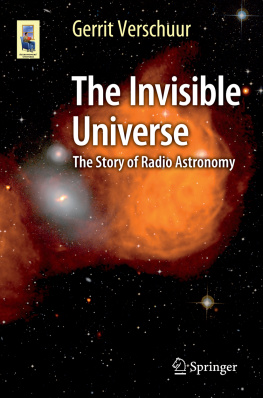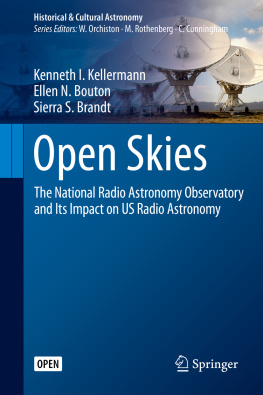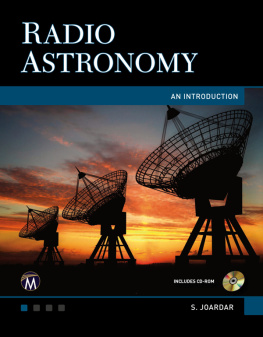The subject of this book can be broadly described as the principles of radio interferometry applied to the measurement of natural radio signals from cosmic sources. The uses of such measurements lie mainly within the domains of astrophysics, astrometry, and geodesy. As an introduction, we consider in this chapter the applications of the technique, some basic terms and concepts, and the historical development of the instruments and their uses.
The fundamental concept of this book is that the image, or intensity distribution, of a source has a Fourier transform that is the two-point correlation function of the electric field, whose components can be directly measured by an interferometer. This Fourier transform is normally called the fringe visibility function, which in general is a complex quantity. The basic formulation of this principle is called the van CittertZernike theorem (see Chap. ).
1.1 Applications of Radio Interferometry
Radio interferometers and synthesis arrays, which are basically ensembles of two-element interferometers, are used to make measurements of the fine angular detail in the radio emission from the sky. The angular resolution of a single radio antenna is insufficient for many astronomical purposes. Practical considerations limit the resolution to a few tens of arcseconds. For example, the beamwidth of a 100-m-diameter antenna at 7-mm wavelength is approximately 17 . In the optical range, the diffraction limit of large telescopes (diameter8 m) is about 0.015 , but the angular resolution achievable from the ground by conventional techniques (i.e., without adaptive optics) is limited to about 0.5 by turbulence in the troposphere. For progress in astronomy, it is particularly important to measure the positions of radio sources with sufficient accuracy to allow identification with objects detected in the optical and other parts of the electromagnetic spectrum [see, for example, Kellermann ()]. It is also very important to be able to measure parameters such as intensity, polarization, and frequency spectrum with similar angular resolution in both the radio and optical domains. Radio interferometry enables such studies to be made.
Precise measurement of the angular positions of stars and other cosmic objects is the concern of astrometry . This includes the study of the small changes in celestial positions attributable to the parallax introduced by the Earths orbital motion, as well as those resulting from the intrinsic motions of the objects. Such measurements are an essential step in the establishment of the distance scale of the Universe. Astrometric measurements have also provided a means to test the general theory of relativity and to establish the dynamical parameters of the solar system. In making astrometric measurements, it is essential to establish a reference frame for celestial positions. A frame based on extremely distant high-mass objects as position references is close to ideal. Radio measurements of distant, compact, extragalactic sources presently offer the best prospects for the establishment of such a system. Radio techniques provide an accuracy of the order of 100as or less for absolute positions and 10as or less for the relative positions of objects closely spaced in angle. Optical measurements of stellar images, as seen through the Earths atmosphere, allow the positions to be determined with a precision of about 50 mas. However, positions of 105stars have been measured to an accuracy of1mas with the Hipparcos satellite (Perryman et al. ).
As part of the measurement process, astrometric observations include a determination of the orientation of the instrument relative to the celestial reference frame. Ground-based observations therefore provide a measure of the variation of the orientation parameters for the Earth. In addition to the well-known precession and nutation of the direction of the axis of rotation, there are irregular shifts of the Earths axis relative to the surface. These shifts, referred to as polar motion , are attributed to the gravitational effects of the Sun and Moon on the equatorial bulge of the Earth and to dynamic effects in the Earths mantle, crust, oceans, and atmosphere. The same causes give rise to changes in the angular rotation velocity of the Earth, which are manifest as corrections that must be applied to the system of universal time. Measurements of the orientation parameters are important in the study of the dynamics of the Earth. During the 1970s, it became clear that radio techniques could provide an accurate measure of these effects, and in the late 1970s, the first radio programs devoted to the monitoring of universal time and polar motion were set up jointly by the U.S. Naval Observatory and the U.S. Naval Research Laboratory, and also by NASA and the National Geodetic Survey. Polar motion can also be studied with satellites, in particular the Global Positioning System, but distant radio sources provide the best standard for measurement of Earth rotation.
In addition to revealing angular changes in the motion and orientation of the Earth, precise interferometer measurements entail an astronomical determination of the vector spacing between the antennas, which for spacings of100 km or more is usually more precise than can be obtained by conventional surveying techniques. Very-long-baseline interferometry (VLBI) involves antenna spacings of hundreds or thousands of kilometers, and the uncertainty with which these spacings can be determined has decreased from a few meters in 1967, when VLBI measurements were first made, to a few millimeters. Relative motions of widely spaced sites on separate tectonic plates lie in the range 110 cm per year and have been tracked extensively with VLBI networks. Interferometric techniques have also been applied to the tracking of vehicles on the lunar surface and the determination of the positions of spacecraft. In this book, however, we limit our concern mainly to measurements of natural signals from astronomical objects.
The attainment of the highest angular resolution in the radio domain of the electromagnetic spectrum results in part from the ease with which radio frequency (RF) signals can be processed electronically with high precision. The use of the heterodyne principle to convert received RF signals to a convenient baseband, by mixing them with a signal from a local oscillator, is essential to this technology. A block diagram of an idealized standard receiving system (also known as a radiometer) is shown in Appendix . Another advantage in the radio domain is that the phase variations induced by the Earths neutral atmosphere are less severe than at shorter wavelengths. Future technology will provide even higher resolution at infrared and optical wavelengths from observatories above the Earths atmosphere. However, radio waves will remain of vital importance in astronomy since they reveal objects that do not radiate in other parts of the spectrum, and they are able to pass through galactic dust clouds that obscure the view in the optical range.











